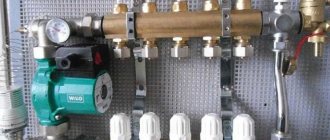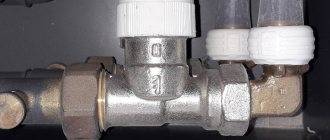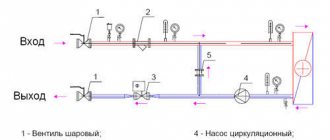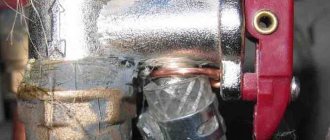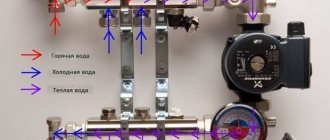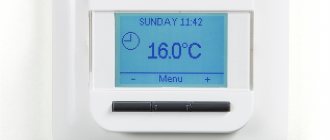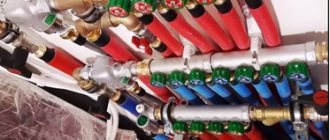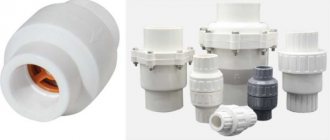Water heated floors, which are gaining popularity, will not function effectively without a special control device - a thermostatic valve. It allows you to control the temperature level of the coolant and adjust the operation of the floor.
In this article we will look in detail at the purpose of thermostatic taps.
We will tell you what types of mixing valves there are, their design and operating principle, and how to choose the right model.
Drive types and selection criteria
Automatic valve with electric drive
According to the type of drive, the models are:
- Mechanical
, the separator is installed manually. To monitor temperature indicators, a thermometer is installed on each incoming pipe. - Automatic
, the movement of the membrane depends on the temperature and is carried out independently.
The drive can be:
- Thermostatic
, in which the sensitive element expands under the influence of temperature and begins to put pressure on the valve stem, mixing cold flows with hot ones. - Electrical
, in which signals are supplied from the control unit. - Cap type
, the tap is controlled by pressing the head on the drive rod; the drive is applicable when installing a floor heating system.
When choosing a three-way valve, the main thing is the type of actuator. Manual drive control is cheaper, but has few functions. Electric models are expensive and break down quickly, but their versatility does not leave most consumers indifferent. Bronze brass faucet material is durable but also expensive.
The best option is cast iron, copper.
When choosing, take into account:
- Media consumption.
- Strapping diagram.
- Operating parameters.
Flow and temperature must be indicated in the design documentation; if it is not available, the optimal water heating temperature is indicated in the passport, usually not higher than 50 degrees. Flow is taken into account when selecting a valve based on its capacity.
The type of drive must correspond to the wiring diagram.
A thermostatic valve has a simpler scheme, in which water circulates through the third pipe to the first, the boiler heats it, and only after that the coolant begins to warm up. Having heated up to the required temperature, out of three possible ones, the tap opens flows of cold water from the second pipe, replacement occurs, cold water leaves, hot water enters the tank with a heat accumulator.
The piping scheme is more complicated when an external controller is installed on the crane.
In this case, dual-drive and dual-circuit mixers will be required. The first circuit is installed next to the heat source and is thermostatic. The second drive is electric, controlled by the controller by sending sensor signals, the faucet maintains the temperature of the coolant.
An important criterion when choosing a device is the temperature range
, products, as a rule, in this case have a thermostatic drive in the piping of hot water boilers and underfloor heating systems. The range of taps depends on the purpose of the products, ranging from 20-43 grams, 35-60 grams and above. It is advised to stick to the second option when purchasing.
When installing the piping, it is worth asking how the tap is checked. If the product is new, it is not difficult to check it; the minimum temperature in the range is set in the third pipe, hot water is poured. After 15 - 20 minutes, the pipe should turn off the tap.
You can check the device in an already installed system by measuring the water temperature at the entrance to the boiler, that is, on the back side of the pipeline the value should be the same as on the thermostat.
Strapping diagram:
Changing operating modes of heated floors
The thermostat is an effective solution for monitoring the water temperature in the heating circuit. This method is inexpensive and accessible to almost every owner. The boiler heats the water to 90 degrees, and water should flow to the floors at a temperature twice as low.
The desired degree can be achieved thanks to the thermostatic head:
- The supply of hot water is short-term - the water fills the pipeline, the supply ends until it cools to an acceptable temperature;
- Constant water supply with the addition of cool coolant from the return pipe.
Periodic short-term supply
With a short-term water supply, the system works in a small space - a bathroom, ceramic floor in the toilet, shower room and other places. At the supply point there is a valve with two strokes, a remote-type floor sensor and a thermal head.
As soon as the circuit is filled with coolant, the sensor is triggered and the flow is blocked by the valve. After some time, the screed will cool down, the valve will open again and hot water will fill the system. This circuit is economical and can replace the mixer unit.
For heated floors, special thermal heads from the RTL series have been developed, without an external sensor. They are installed on the return line to maintain the set water temperature without depending on the heating of the floors. By installing this model of thermostat, the automation changes the threshold heat values (no more than 40 degrees Celsius).
The installation feature is installation in an exclusively horizontal position. Experts from Moscow do not recommend setting the water level in the floors lower than the temperature in the room.
Periodic short-term injections of water into the circuit allow you to maintain stable movement along the coolant circuit without overheating the system.
Constant coolant supply
A constant supply of water requires the installation of a three-way valve in the system, complemented by a floor sensor and a thermal head. Using a tee, a connection is made from the return to the third stroke of the mixing unit. The direct water supply must always be open, so the valve must be installed professionally and correctly.
Experts recommend installing the thermal head on a three-way valve using a locking type axle box. When the sensor heats up, the valve stem moves and a gap is formed inside. This gap receives cool water from the return line.
This sequence of work allows the coolant to stably enter the circuit, while the temperature remains within acceptable limits. Due to the continuity of the flow, the floor covering quickly heats up to 28 degrees Celsius and remains comfortable for the owner, and the circuit does not overheat.
Pipes and screed will last longer due to the absence of excessively high temperatures. The addition of cold coolant is important for heating large rooms where a comfortable temperature is needed.
Adjustment mechanism
Thermostatic mixing valve
A thermostatic mixing valve is also used in radiator-type heating schemes, but convective air circulation (even with balanced ventilation and careful insulation) still leaves the lower layers as the coldest part of the room.
The source of thermal energy can be either a central heating plant or an autonomous boiler. In any case, boilers operate effectively in stable modes and will not provide smooth adjustment of coolant flow in each individual room.
For this purpose, special fittings with selected operating parameters and a specific type of design are included in the system. Installing a mixing valve for underfloor heating gives the following stabilizing result in normalizing the temperature in the house:
Mixing valves perform the task of combining a high-temperature heating circuit with a low-temperature underfloor heating distribution, since the recommended temperature in the pipes under the floor is 40°C, and for the water leaving the boiler 70 - 90°C.
Work principles
If the coolant is too hot, a cold stream is mixed into the water
The three-way valve for heated floors performs its function in the following order:
- the hot coolant from the boiler is directed to the distribution manifold, from which it diverges through the loops of the underfloor heating system;
- a thermo-mixing valve is installed along the path of movement, reacting to the heating temperature of the water;
- when the flow temperature exceeds the set value on the regulator, the latter opens a passage for mixing cooled water from the return pipeline;
- in the tee, two converging flows are mixed and the coolant of the desired temperature is released into the system;
- When balance is achieved, the change in the internal sections of the valve stops.
The valve body is made of brass and consists of 3 channels converging to the adjustment mechanism. The use of 3 different methods of mixing water flows distinguishes 3 types of three-way valve designs.
Three way thermostat
The thermostat mixes hot and cold flow
The set temperature is maintained by a three-way thermostatic valve, which automatically mixes the hot liquid flow from the heater and cooled water from the return pipeline. The need for quantitative changes in flows is determined by the thermostat settings.
This product can be used in underfloor heating systems (especially complex configurations), on radiator wiring and in the internal hot water supply circuit.
Automatic change in the temperature of the outgoing coolant protects a person from elevated temperatures in the event of a pipe rupture. If for some reason the flow of cold water stops, the valve will automatically close the flow of hot pressure from the boiler. The temperature-sensitive unit responds to the amount of heating and, accordingly, changes the cross-section of the inlet holes, achieving the required balance.
The layout of the thermostatic valve for a heated floor looks like this:
A pressure throttle is a device that provides fluid pressure regardless of the pressure difference at the inlet and outlet. Paired with a thermal head for a heated floor, it stabilizes the operation of all system circuits when incoming conditions change.
3-way thermostatic valve
The operation of this valve is not as complicated as a thermostat. Only the incoming hot media is regulated. For more information about the operation of three-way valves, watch this video:
To analyze changes in temperature indicators, the kit includes a thermal head for heated floors, which acts as an executive body based on a signal from an external sensor.
Mixing valve
Manual valve adjusted manually
The three-way mixing valve, which is not equipped with sensors and automation, is even simpler. The manual valve needs to be forced to set the position of the regulator to obtain the desired outlet temperature.
This crane is manufactured in 2 types:
- has a T-shaped passage (symmetrical design);
- internal L-shaped passage, (asymmetrical).
The differences are that with a symmetrical scheme, 2 jets meet from opposite arms of the valve and go into the side branch already in a mixed state.
Types and their structure
In a thermostatic distribution valve installed on a heated floor, the heated water is mixed with cooled water from the return pipe. This process is continuous as long as the heating is on.
There are two-way and three-way mixing valves for underfloor heating. They also differ in the method of mixing and the direction of flow.
Two-way
The two-way thermostatic valve is an improved manual type model. It can be hydraulic, pneumatic or electrically driven.
The design is simple, but capable of effectively regulating the temperature level of the coolant in automatic mode. The device is mounted in the heating system, instead of a manual valve.
Main advantages:
- Automatic reduction of liquid temperature level;
- Simplicity of design and low price;
- Easy installation.
Disadvantages - the possibility of installing it on pipelines with a small size. If you use this faucet when installing heating in a room with a large area, the thermostat will function intermittently. A two-way valve is more often used if heated floors act as additional heating.
The valve device is a brass or bronze body, with one or two seats. A double-seated valve can completely shut off the flow of water.
The device is equipped with a thermostatic head with a scale. The head position can be changed manually or automatically. Manual models are simple and inexpensive. More modern devices work automatically.
The two-way valve operates according to the following principle - the coolant from the return line is again supplied to the floor pipes, but before this, a device is activated that opens the supply of heated water. The two flows are mixed inside the housing to the desired degree, then the temperature sensor is triggered and the shutter automatically closes the hole with the hot coolant.
The valve consists of a plunger and a seat. The plunger has a disc, needle and rod shape. It is located perpendicular to the movement of the fluid.
Three-way valve
The operating principle of a three-way thermostatic valve for floor heating is that cooled water from the return line is added to the hot water coming from the boiler.
The valve is designed for heating systems that are installed in large rooms. They have the same advantages as two-way valves. Particularly worth noting is the ease of adjusting the water temperature for heated floors.
But this thermostatic valve also has a minus - if the thermostat is triggered, the valve opens completely, thereby allowing hot coolant to enter the circuits. And this can cause overheating of the heating system, and even rupture of pipes. In addition, it has a lower flow capacity than a two-way valve.
Three-way thermostatic mixing valves are available in brass and bronze. They are equipped with a thermal head or thermostat, and can have an electric drive or a servo drive. The design is a faucet with two inlets and an outlet. Inside the case there is a mixing chamber, on which there is a thermostat with a regulator on which there is a digital panel. A thermal valve is connected in front of the manifold.
Operating principle of three-way thermostatic valve:
- heated water moves through the right and front pipes - if its heating degree meets the required parameters;
- if the temperature of the liquid increases or decreases, the thermostat comes into operation, it sets the rod in motion, as a result, cooled water is mixed with hot water;
- after reaching the set temperature, the front hole opens completely.
It should be said that when the device is turned on, the water flow voltage does not change. This leads to a uniform change in the temperature of the liquid supplied to the line.
By mixing method
Mixing taps for heated floors, depending on the mixing method, are:
- With a thermostat function - with it it is possible to achieve and maintain the desired degree of heating of the coolant, since the device is able to regulate both flows (heated and cooled). The thermostat in the mixer, reacting to the level of heating of the liquid, opens or closes the hole through which heated or cooled coolant is supplied. In addition, the mechanism is designed in such a way that in the absence of cold water, the automation shuts off the flow of hot water.
- Thermostatic - the device is equipped with a sensitive thermal head that has an external temperature sensor, it is located in each line. The operation of the valve is to determine the water temperature and send a command to the actuator.
Types of 3-way valves
All thermostatic three-way valves for heating are divided into 3 types according to their design and operating principle:
- mixing;
- dividing;
- switching.
The purpose of each of the 3 varieties can be judged by its name. The first type of valve mixes two coolant flows with different temperatures, the second one separates, the third switches water between 2 lines. It is not difficult to recognize them externally; usually the principle of operation is depicted on the body in the form of a picture. Here's what a three-way mixing valve looks like:
The nameplate from Herz clearly shows the mixing of 2 flows, which means this is a mixing valve
A similar designation appears on the separating element. As for switching taps, there may not be an image on their body, but there are significant external differences in shape.
Separating (photo left) and switching (right) 3-way valve
By mixing or separating flows, the optimal temperature of the coolant supplied to the radiators of the heating system or underfloor heating circuits is achieved. Switching is used in gas double-circuit boilers, when heated water must be alternately directed to different heat exchangers.
Characteristics of two way valve
The two-way valve is an upgrade to the valve. Built into the collector, it operates automatically and maintains the set temperature level. Unlike a traditional valve, this model is focused on passing liquid flow in one direction. If you install it back, the entire process of functioning of the heated floor will be disrupted. To extend the service life, a filter is installed in front of the valve to retain mechanical impurities.
Thermal mixing unit for heated floors
Two way valve diagram
Thanks to this scheme, the heated floor does not overheat, therefore, its service life is extended. Since the throughput of a two-way valve is relatively low, temperature control is smooth, without jumps. Experts recommend using this device when installing heated floors over a large area exceeding 200 m2.
Water circuit installation diagrams
If the installation of warm water floors is carried out using a well-established, traditional technology in a clear sequence, then the installation of a heating pipe can be carried out in various variations. The main goal pursued when installing heated floors is to uniformly heat the entire area of the heated room. Laying a pipeline just the way you want means deliberately creating problem areas throughout the entire structure. The coolant tends to quickly lose temperature as it flows, so the pipes must be laid starting from the walls, then moving towards the entrance to the room or to its center. For this purpose, specially developed optimal schemes for laying the water circuit, each of which has its own characteristics.
The mixing unit and manifold are the beginning of the entire heating system. Water circuits are connected in a clear sequence. The beginning of the pipeline is to the inlet pipe, the end of the pipe is connected to the check valve.
You can install a warm water floor with your own hands, the contour of which will be laid as follows:
- pipe installation according to the snake pattern"
- laying the pipeline according to the snail pattern;
- combined scheme.
When installing heating in corner rooms, a pipe laying scheme is used for enhanced heating.
In each individual case, we can talk about the advantages of one or another scheme. For example: a snail is the simplest circuit. The bend of the pipe here reaches 900, while in a snake the heating pipe will be bent by 1800.
Where heated rooms have a linear slope, it is better to install the pipe according to the “snake” pattern. The pipeline is laid in the direction from the mixing unit towards the slope. Air pockets in this version can be easily removed, which cannot be said about a pipe laid in a snail pattern. In sloping rooms, removing air pockets can be problematic.
For large premises where it is necessary to use several water circuits of the same length for heating, the “snake” pipeline laying scheme is very convenient. Thanks to this installation method, it is possible to achieve balanced operation of the entire heating system.
Heating pipes laid on a prepared base are connected to a manifold that distributes the supply of coolant to the system. The distribution cabinet together with the mixing unit is installed either in the heated room or next to it, which significantly reduces the number of pipes and the consumption of other materials. The bends of the water pipe at the point of connection to the collector are sewn into a special protective box.
In each individual case, a certain order of laying the water pipe should be followed. When working with a snail circuit, the pipe is first laid along the perimeter of the walls, after which a turn follows from the farthest wall. In the opposite direction, the pipe is laid in a spiral, reaching the center of the heated room. For the snake circuit, the water circuit is laid out as follows. The pipe is laid along the perimeter of the walls, after which uniform bends are made in the opposite direction.
The combined installation schemes of heating pipes for heated floors, used in some cases, involve the simultaneous use of both options. One half of the room can be heated by a water circuit laid in a snake pattern, while the other part of the room will be heated by a pipe mounted in a snail pattern.
Mechanical thermostat: operating principle
If the air space in the room is heated to the required level, the working sphere in the bellows expands under the influence of heat, which causes the hydraulic cylinder to straighten. The rod, combined with the bellows, rushes forward, exerting pressure on the hydraulic valve, pressing it closely against the through hole. In this case, the supply of coolant to the battery (heating) stops.
After the remaining media in the heating battery has cooled, the mixture (or gas) in the thermoelement is compressed, causing its walls to shrink, which leads to the opening of the valve. The heated coolant enters the system, then the course of action begins all over again.
Temperature adjustment
The operating temperature of the underfloor heating fluid may vary depending on the quantity, length of circuits and general operating conditions of the system. The main value is the temperature in the circuits; its value is accepted as the most comfortable in the range of 35-45 degrees (up to 55 if the loops are long).
When supplied from the network, the temperature of the medium is too high, such values are unacceptable for pipelines and high-quality regulation is simply necessary. In some cases, it is necessary to install an intermediate heat exchanger, which heats a separate coolant in the underfloor heating system to acceptable values.
When the system is powered by its own boiler, it is possible to initially set the supply temperature, which simplifies the operation of the mixing unit and makes the system operating mode less aggressive.
Constant control of the coolant temperature is the prerogative of sensors working in conjunction with the system control unit (it is often mistakenly called a thermostat, which is not entirely true). A warm floor is a very inert system that reacts to any impact with a delay. Therefore, constant monitoring of small fluctuations with immediate temperature correction is necessary to avoid significant changes in operating conditions.
Adjustment can be carried out on a simple mechanical principle - like a thermal head - to a complex system of temperature sensors located directly next to the heated floor pipes and collecting information on a common control unit, which, using servo drives, regulates the operating parameters of the system and displays the data.
Subtleties of installing a thermostatic mixing valve
The three-way mixing valve can be installed in heating systems with one or more circuits by placing it in the mixing unit. It is noteworthy that the connection diagram for a three-way valve for a heated floor will not change depending on the number of circuits (read: “How a three-way mixing valve for a heated floor works, types, application”). The only difference is that the system will be equipped with additional parts.
Additional circuits are needed just to connect the warm water floor pipes to the heating
Please note that according to the connection diagram for a heated floor with a three-way valve, it is mounted in front of the pressure pump. This is a prerequisite for the high-quality functioning of the heating system.
When performing tapping work, it is important to ensure that the valve is not clogged with slag or splashes of molten metal left by the welding machine. In addition, the valve must be removable so that it can be checked and, if necessary, replaced. If you do not have the appropriate skills, it is better to entrust the insertion of the control valve to professionals.
If you do not have the appropriate skills, it is better to leave the tapping of the control valve to professionals.
What does a three-way valve with a thermostat do?
This valve narrows the flow of water, due to which its quantity decreases, and the outgoing heat is supplied in smaller quantities. The device is responsible for regulating the amount of water to control the temperature in the room or floor.
Device
In terms of external characteristics, a three-way valve for heating with a thermostat is very similar to an ordinary tee for dividing water, but in fact, all parts of this “tee” perform special functions.
- Thermal head with durable sensor. With the help of such a device, the temperature of the water entering the valves is adjusted and regulated.
- The upper poppet and lower poppet valves are necessary to start the mechanism, as they optimize the operation of the main valves, distilling water and thereby giving it the required temperature.
- One valve through which hot water enters the three-way valve.
- The second valve through which cold water enters the device.
- The third valve, from where, through the operation of the upper disc and lower disc, water is formed at the temperature that is set through the thermostat.
- Pressure relief chamber. This equipment controls the water pressure in the valves, increasing their performance and relieving them of pressure.
- Gland seal. The device guarantees the tightness of the entire structure. It is necessary due to the fact that the compartments and the heating circuit quickly fail due to any minor breakdown, since water “does not like” when it is handled carelessly, and when the opportunity arises, it tries to flow out of the pipes, flooding the surrounding space.
Principle of operation
There are two types of design:
- saddle;
- turning.
The principle of operation depends on what type of design is installed on the device.
- If it is a saddle, then the movement rests on the translational movement, where the rod constantly enters the saddle, then flies out of it.
The seat is either completely closed by the stem, or only slightly opens the mouth, releasing water. Thus, the saddle type of structure drives water and regulates the amount of hot or cold liquid coming out of two valves, while simultaneously mixing and transferring the resulting water in temperature and quantity to the “mixing” compartment.
- If it is rotary, then the regulator becomes not a rod, but a small ball or sector (part of a sphere). A device such as a conventional ball valve works: the ball rotates, allowing the passage of liquid either from a compartment with hot water or from a cold water tap, as with a saddle-type system, only instead of a rod there is a ball that operates without a seat on the overlap of two valves. Mixed water comes out of valve 3, set at temperature through a thermostat.
The temperature set through the device is maintained between two compartments with hot and cold water supply. When it changes, the gas located in this place begins to narrow or expand, depending on the change in the adjustment parameters.
This gas presses on the rod or ball, opening one of the valves, thereby flowing out the required amount of water and creating a new temperature corresponding to the set one.
Types of Valve Actuators
Valve Actuator Types:
- Direct acting valves. They function as follows: when the temperature changes, the expanding gas presses on the ball, sector or rod.
The thermal part of the three-way valve is located here, however, this equipment is not present in all devices. The sensor in such a device can be a probe located inside the pipeline.
- Indirect acting valves. They work in much the same way as direct-acting valves, differing only in smaller, but no less important, functioning.
Three way thermostatic mixing valves:
- Mixing. Such a device has 2 pipes, one of which is output. The first pipe is equipped with warm or hot water, and the second is connected to the “return” system, i.e. all the cooled water remaining after the previous heating is returned to it. When both pipes are opened, the water is mixed and, under the control of the thermostat, the desired outlet temperature is set. Then the water spreads throughout the entire circuit.
- A separating valve is a device that works inversely to a mixing valve, not combining water into one stream through the outlet, but, on the contrary, dividing a whole mixture of water of different temperatures into hot or cold. For this type there is one entrance and two exits. The design is used in bathrooms, if it is necessary to have hot water only from one tap and cold only from another tap.
DIY valve installation
We present to your attention several schemes for installing a mixing valve.
A scheme that is used mainly in boiler rooms of heating systems that are connected to a hydraulic separator or to a free-flow collector. The pump, which is located in the second circuit, ensures the necessary circulation of the coolant.
Attention! In the case when the valve is planned to be directly connected to the coolant source on the bypass, which is connected to port B, then it will be necessary to install a valve with hydraulic resistance, which will be equivalent to the same resistance of this source
If this is not done, then the coolant flow in the segment A-B will fluctuate depending on the movement of the rod
It is worth noting that this installation scheme provides for a possible interruption of coolant circulation through the source if the installation is made without a circulation pump or hydraulic separator in the main circuit.
If this is not done, then the coolant flow in the segment A-B will fluctuate depending on the movement of the rod. It is worth noting that this installation scheme provides for a possible interruption of coolant circulation through the source if the installation is made without a circulation pump or hydraulic separator in the main circuit.
It is not recommended to connect the valve to a pressure manifold or heating networks in the absence of devices that can throttle excess pressure. Otherwise, the coolant flow will fluctuate seriously.
If the return is overheated, it is allowed to get rid of excess pressure using a jumper, which is mounted parallel to the valve mixture in the circuit.
Carrying out quantitative adjustment by changing fluid flow rates is the main function performed by this three-way thermal valve. It is used where it is possible to bypass liquid to the “return”, but stopping circulation, on the contrary, is extremely undesirable. We also present a diagram for installing a three-way separating valve:
Important! A similar connection scheme has become quite popular in water and air heating units connected from individual boiler houses
In order to link hydraulic circuits, it is necessary that the consumer's pressure losses be equal to the losses on the valve - balancer in the bypass
The diagram shown here should be used for installation on those pipelines in which there is excessive pressure. The movement of liquid is carried out due to strong pressure, which is formed using a circulation pump.
In order to link hydraulic circuits, it is necessary that the consumer's pressure losses be equal to the losses on the valve - balancer in the bypass. The diagram shown here should be used for installation on those pipelines in which there is excessive pressure. The movement of liquid is carried out due to strong pressure, which is formed using a circulation pump.
Adjusting the heating of water floors
Most often, to install water floor heating, they use a connection of heating circuits through a manifold, to which both ends of the pipeline go: one of them supplies the coolant, and the other returns it back. Hot water at the same temperature enters the inlet of each heating circuit.
Since the length of the pipelines is different, each room is heated to a different temperature. For example, for a bathroom this parameter should be 25 degrees, and for living rooms it cannot exceed 22 degrees. To add or decrease the degree of heating of the room, you need to change the amount of coolant supplied to the circuit.
The simplest way to regulate the temperature of a water heated floor is to equip the collector with special valves for the inlet and outlet (more details: “Diagram of a heated floor collector - how everything should work”). By turning their heads, you can adjust the amount of coolant supplied to each of the circuits. In this case, you have to rely only on your own feelings, and this method of adjusting the heating cannot be called convenient.
The sequence of actions is as follows:
- the control valves are tightened;
- wait for some time until the floor warms up;
- evaluate the result;
- tighten the valves again, etc.
Since the temperature outside is almost never the same for even one day, home owners have to turn the valves very often, manually.
The thermostats shown in the photo are usually placed in each room where hydronic floor heating is installed. In turn, each circuit on the coolant supply comb is equipped with servo drives. They, according to signals, increase or decrease the amount of water supplied to the circuit. Thermostats are connected to specific servos and send control commands to them.
Regulators control either the temperature of the warm water floor or the air mass in the room. At the same time, it is necessary to monitor the air temperature in the room when heating the floor surface is the only method of heating in the house.
Operating principle of a heated floor controller:
- The required temperature (floor surface or air, depending on the specific model) is set on the equipment body.
- If the parameter deviates in one direction or another, a signal is sent to the servomotors, after which the supply of coolant either increases or decreases. As a result, after a certain period of time, the temperature returns to normal.
How to choose a thermal head?
The floor covering heating system has a mixing unit, the most important element responsible for changing the parameters of the heating circuit. This is due to the fact that the moisture from the heating equipment enters the pipeline too hot, sometimes up to 90 degrees Celsius, and inside the screed there can only be a maximum of 40 degrees Celsius.
In order not to overheat the system, a thermal head is installed on the damper, maintaining acceptable parameters of the coolant. The mixer is responsible for bringing together the temperatures of different flows, as a result, antifreeze or water of the required and permissible temperature enters the water circuit.
Types of thermal heads
Depending on the substance in the bellows, thermal heads can be gas, liquid or paraffin based. Liquid - inertial, working slower, taking a long time to heat up and cool down, but the most accurate.
Gas ones have a large error and are vulnerable to drafts. Inside the head there is a mnemonic diagram on which zones with temperatures are marked.
The thermal head can be controlled mechanically or electronically. Manual, mechanically controlled, have a radial scale with marks of 2...5 degrees. Turning the knob will increase the distance between the elements and increase the pressure on the rod.
Electronic devices are controlled by a display, and an electric drive presses on the rod. Such equipment is more expensive, but is highly accurate.
The thermostat contacts the surface in several ways, so the thermal head can be a surface-mounted one, with an air sensor, or an immersion type.
The thermostat heats up at the place of fixation, and the overhead and air thermostats are connected to the sensor by a sealed capillary-type tube. The bellows expands from the heating of a canister located remotely - such units are used in heated floors.
Scope of application and installation nuances
Installation of a mixing valve for heated floors is intended to achieve the following goals:
- protection of a solid fuel boiler from condensation and overheating due to sudden power outages;
- reducing and maintaining the required temperature in heated floors;
- separation of coolant supply to different elements of the system.
The temperature of the coolant in the heated floor system cannot exceed 45-50 degrees, in order to avoid various damage to both the system and the finishing coating.
To protect the solid fuel heating element during warming up, do not allow cold coolant to enter the boiler from the return line. They use the following scheme: until the coolant warms up to 55-60 degrees, it circulates in a small circle. When the temperature rises to operating mode, the valve opens and directs the entire flow to the radiators.
In warm water floors, the valve performs essentially the same role. The circulation pump pumps hot coolant through the pipelines until it begins to cool or overheat. When one thing or another happens, the sensor is triggered, and the thermostatic head or drive begins to move the valve stem and regulate the mixing of the coolant to the desired temperature.
One more example. To quickly warm up a heat accumulator, a temperature of about 80-90 degrees is needed, but such a temperature is absolutely unacceptable for heated floors and radiators. A three-way valve with a separate pump installed after the accumulator helps lower the supply temperature to the rest of the system through admixture.
When installing a thermostatic mixing valve, you should pay attention to the location of the circulation pump, which is always located on the side of the open pipe
In the heating system, the highest temperature is in the boiler; it is connected to the boiler directly, and the remaining elements are connected through a three-way valve, since they need temperatures lower than the original one.
There are inexpensive valves of a simplified design; the control element is located in the body and autonomously maintains a fixed temperature, which is usually indicated on the body. Its advantage is its low price, but its disadvantage is the lack of customization. A three-way valve with a thermal head or drive is a useful and sometimes irreplaceable element in a heated floor system, and indeed in the entire heating system. It makes it possible to use heating fluid efficiently and economically. In some systems it serves as an element that protects against damage and breakage.
Place and role of mixing valves in the heating system "warm floors"
The main task that consumers have to face when deciding to install heated floors in their home is to achieve the required coolant temperature. For radiators, water at a temperature of 750C is quite acceptable, which cannot be said about pipes that are laid in the thickness of a concrete screed.
Important! Excessive heating of the concrete screed leads to a deterioration in the temperature balance inside the heated room. At high temperatures, flooring (in most cases wood-based) quickly loses its aesthetic and technological qualities, becoming unusable.
In accordance with sanitary standards, the normal heating temperature of heated floors should not exceed 260C. Then the middle layers of the air mass inside the room warm up to comfortable values of 20-220C. In order to obtain such temperature parameters, the water entering the loops of the water circuit must be heated to 500C. Slightly less than 50% of the thermal energy of the heated water is spent on heating the layered cake of the heated floor. Taking into account the thickness of the concrete layer, material and type of floor covering, the temperature on the floor surface decreases.
A mixing unit, which is a set of interconnected instruments and devices, helps to achieve a significant reduction in the temperature of the boiler water at the entrance to the heating water circuits. One of the main roles in the operation of the mixer is played by the thermomixing valve, which mixes water for the heated floor. Thanks to this small device, two streams of water are mixed, cold and hot, so that the output is water at the required temperature. Valves installed in mixing units are of two types, three-way and two-way. Each type of crane performs its own tasks and functions determined by the technological process. Which device is best to use for your heated floors? What is behind the choice of the type of mixing and control device?
Thermostatic valve and control valve - differences
The use of thermal valves on a single-pipe heating system is especially important, but only if it is not flow-through. That is, if there are jumpers at the junction of the radiators - bypasses. It happens that there are no bypasses. As a result, the coolant sequentially passes through all radiators, one after another. Installing a thermostatic valve on such a system can only cause harm. Because the thermostatic valve will turn off all radiators located after it. Therefore, if for some reason it is very necessary for a flow-through system, it is better to install a control radiator valve. And don't cover it completely.
The difference between a control valve and a thermostatic valve is the ability to adjust the gap for the passage of coolant - more or less. The thermostatic valve, on the contrary, can only be in two positions. Firstly, it is open to a certain, previously adjusted level. Secondly, it is completely closed. Therefore, there is no need to install a thermal valve on a flow-through heating system without bypasses. Since, when the valve is closed, the circulation of coolant throughout the system will stop. This will create cooling and unbalance the heating system. It will also have a negative impact on the heating boiler. The situation can be aggravated by the absence or poor functioning of the safety valve. That is, a breakthrough may occur in one of the weak points of the system.
What materials are they made from?
Corrosion-resistant metals are used to make the thermostatic valve body:
- Brass.
- Bronze.
- Stainless steel.
Additionally, the surfaces of brass products are nickel-plated, and the bronze body is either also nickel-plated or coated with a layer of chrome.
Advantages and disadvantages
The advantages of installing thermostatic valves in the heating system include the following factors:
- Energy independence of the device.
- Compactness.
- High precision temperature control.
- Easy to operate and highly reliable.
- Aesthetic appearance.
- The optimal combination of price and functionality.
The disadvantages of using thermostatic valves are:
- Difficulty setting up.
- There is a danger of the thermal head malfunctioning under the influence of a draft or a nearby stove.
Thermal heating valve - purpose
Thermostatic valve for heating systems is designed to automatically open and close the radiator inlet. When a certain room temperature is reached. In other words, if the room is too hot, you can install a thermostatic valve on the radiator. Thereby achieving a more comfortable temperature in the room. Moreover, thermal valves are intended for steel, aluminum and similar radiators and convectors. That is, for quickly heating and quickly cooling devices. Thermal valves will work on cast iron heating radiators. However, it is not very effective.
Thermostatic valve VALTEC – angular, with thermal head
In some cases, a thermal valve can help even when the radiator heats poorly.
If your home's heating system is poorly balanced. For example, the first radiators from the boiler heat up strongly, while the last ones are barely warm. But by installing thermal valves on the first heating radiators along the coolant flow, this imbalance can be corrected. And of course, achieve stronger heating of those radiators that previously heated weakly. Date: September 25, 2022
Equipment characteristics
The coolant from the boiler passes through the pipe line to the collector. From it the liquid flows into the floor pipeline. Giving up heat, it returns back to the collector, which has a separate return outlet for the cooled coolant. The circulation pump forces water back into the boiler.
When manually controlling the temperature regime, valves are installed on the circuit with cold water and high-temperature coolant. If the room has warmed up well enough, then the hot water valve is closed. If the room is cold, the valve is opened.
To automatically regulate the heating mode, install a three-way mixer with a thermostat and an external temperature sensor. This system forms a thermostatic valve. It is installed at the entrance to the collector. The equipment is made of brass or bronze.
- The three-way valve has 3 outlets for hot, cold water and coolant, which is supplied to the floor line. Markers on the body indicate the direction of flows of different temperatures.
- A mixing chamber is provided to mix liquids of different temperatures.
- On the body there is a thermostat with a temperature regulator.
- The temperature sensor is located on the thermostat.
- The valves close the outlets for cold and hot flow. They can be disc-shaped or needle-shaped. Their operation depends on the thermostat.
- The thermostat is a system that consists of a capsule with liquid and a spring-loaded rod. Valves are attached to it.
- The temperature sensor has a digital panel on which the heating modes are indicated.
We recommend: What characteristics does a two-core heated floor have?
The thermostat can be located in the thermal head or in the servo drive. The devices have different circuits, but the same principle of operation. The thermal head is a thermostat, the operation of which is carried out using a liquid: it is sensitive to temperature changes.
Servo drives operate from the electrical network. The liquid is contained in a container. It contains a heating plate. The servo drive is installed on the manifold.
The three-way mixer is designed for heating systems of large areas. In separate rooms or in country houses, a two-way valve is connected to the collector. It is installed on a circuit with a high temperature coolant. Water flows through it in only one direction.
Features of choosing mixing units
Piping of the boiler and other components of the heating system is always done with standardized pipes. At the same time, each developer tries to use threaded connections of the same standard size throughout the entire pipe structure. Here, a design feature of the three-way valve may appear that may prevent the system from operating efficiently and reliably.
Despite the fact that the threaded connection diameter of the mixing unit can be quite significant, this does not indicate the actual throughput. The problem is that the inner diameter of the holes that are blocked by the control head or ball can be 4 or more times smaller than the connecting pipe. Therefore, it is imperative to review the technical documentation in the store.
The key parameter that should be taken into account when choosing a particular product is throughput. Qualified heating system developers are able to provide such a figure for guidance. But if everything was done “by eye,” you need to focus on the performance of the heating boiler. The amount of water it is capable of producing per hour or minute must be compared to the flow capacity of the valve.
Technical Specifications of Three-Way Valve
Conclusions and useful video on the topic
What is a thermal head, what is it for and how does it work.
Analysis of a finished system with a thermostatic valve.
An experiment on the response speed of thermal heads from 4 manufacturers.
The use of thermal valves for radiators allows you to make your heating system as flexible as possible.
With their help, you can regulate the temperature of individual batteries so as to constantly maintain a comfortable microclimate in the room
But at the same time, it is important to take into account the appropriateness of installing such devices and correctly installing and configuring them.
Are you thinking about installing a thermal valve, but want to clarify a couple of installation points? Ask your questions under this article - our experts and site visitors who use such temperature control equipment will try to answer you in as much detail as possible.
If your heating system is equipped with thermostatic valves, please share your opinion with other users. Tell us, which manufacturer’s equipment did you prefer, is it convenient to use, are you satisfied with the result? Write your recommendations in the block, add unique photos of the thermal valve.

